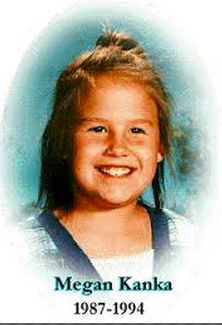 In 1994, 7-year-old Megan Kanka was raped and murdered by her 33-year-old neighbor Jesse Timmendequas in Mercer County, New Jersey. The incident attracted national attention and resulted in the introduction of “Megan’s Law”, which was imposed federally in 1996 by the United States Department of Justice. The requirements of Megan’s Law varies from state to state but at the federal level it requires the following: 1
In 1994, 7-year-old Megan Kanka was raped and murdered by her 33-year-old neighbor Jesse Timmendequas in Mercer County, New Jersey. The incident attracted national attention and resulted in the introduction of “Megan’s Law”, which was imposed federally in 1996 by the United States Department of Justice. The requirements of Megan’s Law varies from state to state but at the federal level it requires the following: 1
- Providing public dissemination of information from states’ sex offender registries.
- Providing the information collected under state registration programs could be disclosed for any purpose permitted under a state law.
- State and local law enforcement agencies must release relevant information necessary to protect the public about persons registered under a State registration program established under the Sexually Violent Offender Registration Act.
Such information made public includes the points listed below:
- Detailed maps centered on the street address one inputs with nearby offenders’ home addresses indicated on the map
- Full names, aliases, and addresses of offenders
- Color photos of the offenders
- A description of the crime committed by each offender
- The ability to check any address including schools, day care centers, and homes of relatives and friends
Requirements vary by state as well as severity of the crime committed.
Table of Contents
What Happened?
 Megan Kanka was playing outside when her neighbor, Jesse Timmendequas, lured her into his house where he proceeded to rape and kill her. Timmendequas placed her body in a nearby park, which he later led the police to after confessing to the crime. The incident attracted national attention due to the fact that Timmendequas had two previous convictions for sexually assaulting young girls. Additionally, in 1981 a judge had labeled him a “compulsive, repetitive sex offender,” yet he was allowed to move to the Kankas’ neighborhood without their knowledge of his past crimes.2 Timmendequas was found guilty and sentenced to death row but is currently serving a life sentence because New Jersey abolished the death sentence in 2007. The incident highlighted the shortcomings of the policies guiding law enforcement agencies that required sex offenders to register into a database but kept the information private and did not mandate that it be shared with members of the community where a sex offender resided. This tragic event aided in initiating public discourse on reform for policies that pertain to sex offenders’ registration requirements.
Megan Kanka was playing outside when her neighbor, Jesse Timmendequas, lured her into his house where he proceeded to rape and kill her. Timmendequas placed her body in a nearby park, which he later led the police to after confessing to the crime. The incident attracted national attention due to the fact that Timmendequas had two previous convictions for sexually assaulting young girls. Additionally, in 1981 a judge had labeled him a “compulsive, repetitive sex offender,” yet he was allowed to move to the Kankas’ neighborhood without their knowledge of his past crimes.2 Timmendequas was found guilty and sentenced to death row but is currently serving a life sentence because New Jersey abolished the death sentence in 2007. The incident highlighted the shortcomings of the policies guiding law enforcement agencies that required sex offenders to register into a database but kept the information private and did not mandate that it be shared with members of the community where a sex offender resided. This tragic event aided in initiating public discourse on reform for policies that pertain to sex offenders’ registration requirements.
The Outcome
Prior to Megan Kanka’s death, the Jacob Wetterling Crimes Against Children and Sexually Violent Offender Registration Act (Wetterling Act) was passed in 1994. This act required that all states establish a registry to keep track of child sex offenders; however, the information was not available to the public and was primarily used by law enforcement. After the death of their daughter, Richard and Maureen Kanka began to demand a better law that would provide the public with critical information about sex offenders in the area. The Kankas garnered over 400,000 signatures on their petition, and with the help of New Jersey General Assembly member Paul Kramer, they were able to pass Megan’s Law within New Jersey, 89 days after Megan’s death. In 1996, Megan’s Law was enacted federally as an amendment to the Wetterling Act. Shortly after, Megan’s parents established the Megan Nicole Kanka Foundation, a non-profit organization that helps advocate for the safety of children.
In 2006, the Adam Walsh Child Protection and Safety Act of 2006 was signed, an act that separates sex offenders into 3 tiers, depending on the severity of their crimes. They are organized as follows:
- Tier 3 (most severe) – must update location every three months with lifetime registration
- Tier 2 – must update location every 6 months with 25 years of registration
- Tier 1 (least severe) – must update location every year with 15 years of registration

The act also established a national sex offender registry system to help improve tracking of sex offenders.3
In 2016, the International Megan’s Law to Prevent Demand for Child Sex Trafficking was passed, a law that requires other countries to be alerted when a sex offender is traveling to their country.4 Megan’s Law is constantly developing to increase the safety of children and decrease the incidents of sex crimes within the United States and beyond.
Criticism
 Despite the fact that more than 20 years have passed since Megan’s Law was first enacted, there are still many questions about the effectiveness of public access to sex offender registries. A 2011 study found that registration requirement without public notification is successful in reducing crime, and its effectiveness increases as the size of the registry increases. However, when public notification is added, the effectiveness of the registry drops slightly and more sex crimes are reported.5
Despite the fact that more than 20 years have passed since Megan’s Law was first enacted, there are still many questions about the effectiveness of public access to sex offender registries. A 2011 study found that registration requirement without public notification is successful in reducing crime, and its effectiveness increases as the size of the registry increases. However, when public notification is added, the effectiveness of the registry drops slightly and more sex crimes are reported.5
Many believe that Megan’s Law is unfair to sex offenders who have reformed and are trying to re-integrate themselves into society. Registered offenders have trouble seeking employment and housing, alienating them from their communities. Homelessness among sex offenders has become such an issue that in 2015 California passed a law that allows low-risk sex offenders to live within 2,000 feet of schools and parks.6 Additionally, past sex offenders have reported feeling isolated, hopeless, or threatened by their status under Megan’s Law, all emotions that could potentially cause a relapse due to a lack of social support.7 Furthermore, minor crimes such as streaking or public urination are considered sex crimes in some states, meaning offenders may end up on the national registry for a crime that did not actually involve sexual abuse.
Despite the availability of a sex offender registry, the state of California still managed to lose track of 44% of its registered offenders due to them eluding authorities by leaving the state. Nationally, 52% of rapists are arrested for new crimes within three years of leaving prison, according to the U.S. Justice Department.8 As of 2013, an average of 1 out of 7 addresses listed on the sex offender registry are incorrect.9 Despite its drawbacks, the intent of Megan’s Law, to provide communities with vital knowledge of offenders within their neighborhood, serves an important purpose in keeping children safe.
Jessica’s Law
In 2005, 9-year-old Jessica Lunsford was raped and murdered by 46-year-old repeat sex offender John Couey in Homosassa, Florida. The young girl’s death launched Jessica’s Law, an act that enacts stricter tracking of released sex offenders. The law was passed in Florida, followed by New York, Texas, and California, but was not passed federally. The law classifies any sexual offense against a child under the age of 12 as grounds for a 25-year-minimum life sentence with a lifetime of electronic monitoring. In California, the law bans any sex offenders from living within 2,000 feet of a school or park and increases the penalties for repeat offenders. Additionally, under this law, failing to register as a sex offenders is considered a third-degree felony.10 This law aims to amend some of the issues of Megan’s Law and help prevent released sex offenders from eluding notice and/or relapsing.

Keeping Your Kids Safe
 Unfortunately, despite efforts by the government, sex crimes are still a huge problem within the United States. Therefore, it is important to make sure that your kids are aware of their surroundings and the risks they face. Here are some tips to help keep your children and other loved ones safe:
Unfortunately, despite efforts by the government, sex crimes are still a huge problem within the United States. Therefore, it is important to make sure that your kids are aware of their surroundings and the risks they face. Here are some tips to help keep your children and other loved ones safe:
- Make sure you know who exactly your children are spending time with. Get to know other parents to ensure that your child is safe, even when out of your sight.
- Make sure your children know that they can talk to you. Communication is key and children should know that they can discuss anything with you.
- Teach your children about their bodies and make sure they know that it is ok to say no to any type of physical contact if they feel uncomfortable.
- Keep track of your children’s whereabouts and have them check up with you every hour or so.
For more tips, check out Megan’s Law- Education. If you have any questions feel free to ask us here!
References
- “Legislative History.” Office of Sex Offender Sentencing, Monitoring, Apprehending, Registering, and Tracking. N.p., n.d. Web. 16 May 2018.
- Glaberson, William. “Stranger On The Block — A Special Report. At Center of ‘Megan’s Law’ Case, a Man No One Could Reach.” The New York Times, The New York Times, 28 May 1996.
- “H.R. 4472 (109th): Adam Walsh Child Protection and Safety Act of 2006.” GovTrack.us.
- “H.R. 515, International Megan’s Law to Prevent Child Exploitation and Other Sexual Crimes Through Advanced Notification of Traveling Sex Offenders (Senate Amendment).” Gop.gov.
- Prescott, J.J, and Jonah E. Rockoff. “Do Sex Offender Registration and Notification Laws Affect Criminal Behavior?” The Journal of Law and Economics.
- Neyfakh, Leon. “California’s Sane New Approach to Sex Offenders.” Slate Magazine, 2 Apr. 2015.
- Levenson, Jill S, and Leo P Cotter. “The Effect of Megan’s Law on Sex Offender Reintegration.” Journal of Contemporary Criminal Justice.
- Greenberg, Jerrold S., Clint E. Bruess, and Sara B. Oswalt. Exploring the Dimensions of Human Sexuality. Burlington, MA: Jones & Bartlett Learning, 2014. Print.
- “America’s Sex Offender Registries (2015).” Smarty Streets
- “Jessica’s Law, California Proposition 83 (2006).” Ballotpedia.
Last updated: 18 April 2018.
